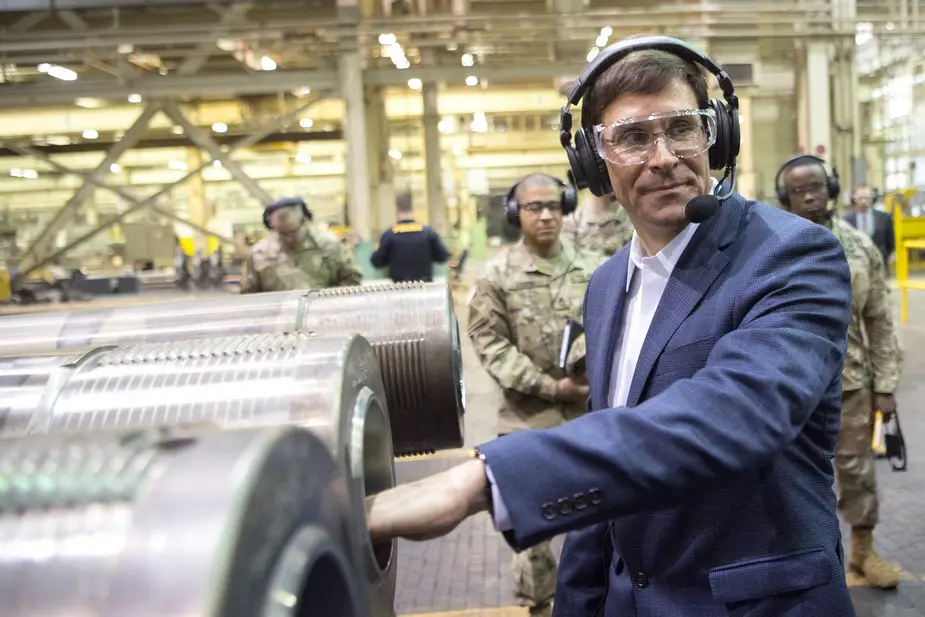Breaking news
U.S. Secretary of the Army Esper: renaissance budget to boost modernization.
In the coming months, U.S. Secretary of the army Mark Esper said he will outline how the Army will consolidate and eliminate some legacy programs, reinvesting more than $25 billion toward modernization over the next five years, Devon L. Suits reports on the U.S. Army website.

Secretary of the Army Mark T. Esper inspects parts at Watervliet Arsenal, N.Y., March 30, 2018. (Picture source: U.S. Army)
"A renaissance is underway in the United States Army," Esper said, adding change "requires bold, decisive action if we're going to be victorious in 2028 and beyond." He said the National Defense Strategy is affecting everything the Army is doing -- from manning and training, to equipping and organizing the force. The secretary shared his thoughts on the Army's budget and other changes during a media roundtable in the Pentagon on Thursday.
FULL BUDGET REVIEW
The Army recently completed a comprehensive review of its entire budget, planning to conduct similar reviews in the future. Notably, the Army reviewed more than 500 "equipping programs" and plans to make some fundamental changes, according to Esper. "We found things that we were probably buying more than we needed. We were probably buying upgrades that we didn't necessarily need," the secretary said.
Moving forward, a bulk of the proposed reinvestment will support the Army's six modernization priorities under the purview of Army Futures Command, Esper said. The reinvested money will be "back loaded" over the next five years to support future acquisition efforts.
Additionally, the proposed request is "not just funding equipment upgrades; it's also funding extended basic training. It is funding the Army combat fitness test … [and] the standup of the irregular warfare office," Esper added.
However, requesting or changing appropriations from Congress can, at times, be difficult, he said. Especially when it means cutting back or eliminating legacy systems. "Many of the programs that we had to either cancel or reduce had merit, but I have to get to the next-generation combat vehicle. I have to build long-range precision fires -- and something has to give," Esper said. "We can take that approach where I can go ask Congress for [an additional] $4 to 5 billion a year. I don't think I'm going to get that."
The Army's six modernization priorities haven't changed in 18 months and won't change in the foreseeable future, Esper emphasized. Additionally, changes to legacy systems will create "billions of dollars a year in opportunity," for companies willing to support. "We're trying to give industry clear indication of where we're going," Esper said. "I've spoken to industry, and I've been very clear to them: 'We are leaving legacy behind. Don't fight the past. Go with us into the future,'" Esper said.
BUDGET CHANGE TO IMPROVE BASIC TRAINING
In line with the changes to the budget, the Army is moving forward with changes to infantry one-station unit training, officially extending the course from 14 to 22 weeks, Esper announced. Infantry soldiers that participated in the pilot back in November 2018 showed improved physical fitness scores when compared to the traditional program. Moreover, attrition rates were cut in half, while the trainees "overall technical performance" improved, Esper said.
This fall, the Army is slated to pilot an extended OSUT program for armor and cavalry units, leveraging upon the success seen during the extended infantry training. If the new pilot program is successful, it could be implemented Army-wide and could spur changes to basic training for other branches, he added.
TALENT MANAGEMENT REFORM
In addition to readiness and modernization, Esper intends to make the Army's talent management a top priority in 2019. Not long ago, Esper engaged with the Army's talent management task force to express his views on the program. The task force was created to support the Army's ability to man, train, employ, and retain high-quality personnel. "We need to tell the force what we expect," Esper said. "My view is we're going to move away from an 'up or out.' My shorthand … is 'perform or out.'
After meeting with the task force, the secretary requested several program deliverables slated for released in the coming months. One of those deliverables is the implementation of the Integrated Personnel and Pay System-Army or IPPS-A. Currently, the Pennsylvania National Guard is testing the new system.
"The system design vision is going to be a market-based system, where talent is managed at echelon. And, in my view, it will centrally manage the top [and bottom] 10 to 15 percent," Esper said. "We need to make that the standard throughout the Army and create the marketplace."


























